最新中国传统文化(英文版)
- 格式:ppt
- 大小:6.47 MB
- 文档页数:25
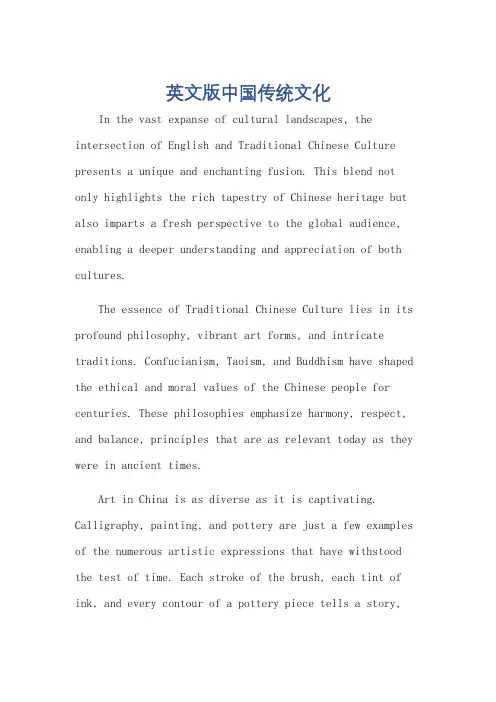
英文版中国传统文化In the vast expanse of cultural landscapes, the intersection of English and Traditional Chinese Culture presents a unique and enchanting fusion. This blend not only highlights the rich tapestry of Chinese heritage but also imparts a fresh perspective to the global audience, enabling a deeper understanding and appreciation of both cultures.The essence of Traditional Chinese Culture lies in its profound philosophy, vibrant art forms, and intricate traditions. Confucianism, Taoism, and Buddhism have shaped the ethical and moral values of the Chinese people for centuries. These philosophies emphasize harmony, respect, and balance, principles that are as relevant today as they were in ancient times.Art in China is as diverse as it is captivating. Calligraphy, painting, and pottery are just a few examples of the numerous artistic expressions that have withstood the test of time. Each stroke of the brush, each tint of ink, and every contour of a pottery piece tells a story,reflecting the artist's thoughts, emotions, and thecultural ethos of their era.Festivals and traditions are another vibrant aspect of Chinese culture. The Lunar New Year, Mid-Autumn Festival, and the Dragon Dance are celebrations that bring joy and unity to families and communities. These traditions are not just rituals but also a way of life, passed down through generations, connecting people to their ancestors and to the land.When Traditional Chinese Culture meets English, it opens up a world of possibilities. English, as a global language, provides a platform for the world to discover the richness of Chinese heritage. Through translations and interpretations, the depth and complexity of Chineseculture are made accessible to a wider audience.In this fusion, we see how English words and phrases are creatively adapted to capture the essence of Chinese traditions. For instance, the term "Confucius sayings" or "Taoist philosophy" are used to introduce Westerners to the wisdom of ancient Chinese thinkers. These translations notonly convey the meaning but also retain the cultural authenticity of the original.Moreover, English has also borrowed many elements from Chinese culture, enriching its vocabulary and expression. Words like "tea," "silk," and "paper" have become synonymous with Chinese culture, reflecting the influenceof China on global history and trade.In conclusion, the enchanting fusion of English and Traditional Chinese Culture is a testament to the power of cultural exchange and understanding. It bridges the gaps between East and West, allowing for a deeper appreciationof both cultures. As we continue to explore and embracethis fusion, we are reminded of the beauty and diversitythat can arise when different cultures come together in harmony.**东西方文化的魅力融合——英文版中国传统文化** 在丰富多彩的文化景观中,英语与中国传统文化的交融展现出独特而迷人的魅力。
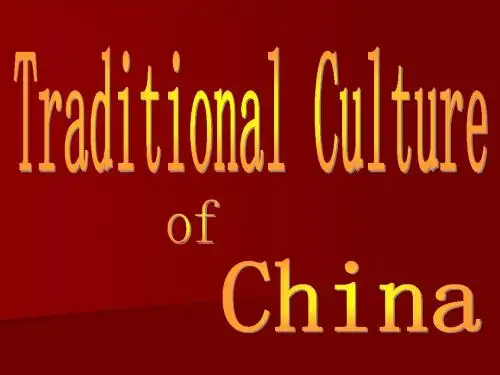
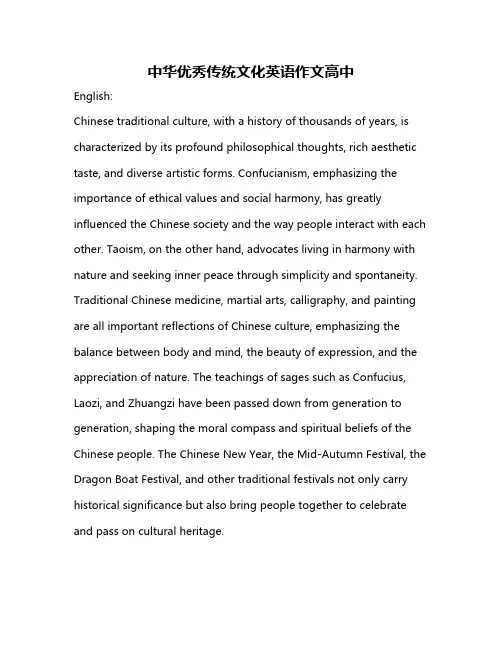
中华优秀传统文化英语作文高中English:Chinese traditional culture, with a history of thousands of years, is characterized by its profound philosophical thoughts, rich aesthetic taste, and diverse artistic forms. Confucianism, emphasizing the importance of ethical values and social harmony, has greatly influenced the Chinese society and the way people interact with each other. Taoism, on the other hand, advocates living in harmony with nature and seeking inner peace through simplicity and spontaneity. Traditional Chinese medicine, martial arts, calligraphy, and painting are all important reflections of Chinese culture, emphasizing the balance between body and mind, the beauty of expression, and the appreciation of nature. The teachings of sages such as Confucius, Laozi, and Zhuangzi have been passed down from generation to generation, shaping the moral compass and spiritual beliefs of the Chinese people. The Chinese New Year, the Mid-Autumn Festival, the Dragon Boat Festival, and other traditional festivals not only carry historical significance but also bring people together to celebrate and pass on cultural heritage.Translated content:中国传统文化具有数千年的历史,以其深刻的哲学思想、丰富的审美品味和多样化的艺术形式而闻名于世。
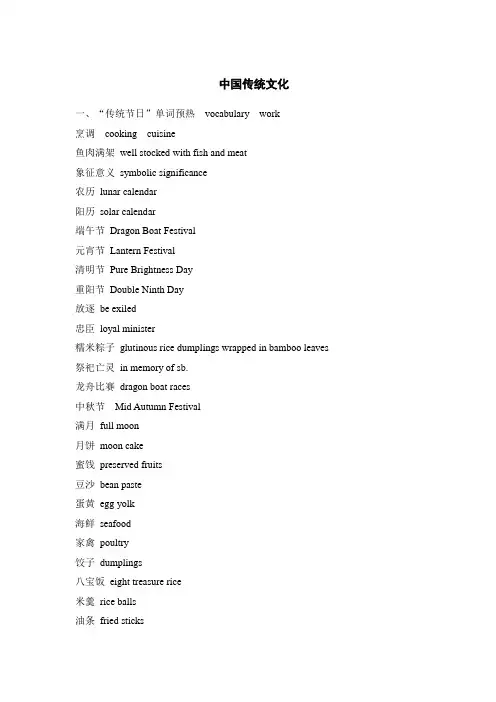
中国传统文化一、“传统节日”单词预热vocabulary work烹调cooking cuisine鱼肉满架well stocked with fish and meat象征意义symbolic significance农历lunar calendar阳历solar calendar端午节Dragon Boat Festival元宵节Lantern Festival清明节Pure Brightness Day重阳节Double Ninth Day放逐be exiled忠臣loyal minister糯米粽子glutinous rice dumplings wrapped in bamboo leaves 祭祀亡灵in memory of sb.龙舟比赛dragon boat races中秋节Mid Autumn Festival满月full moon月饼moon cake蜜饯preserved fruits豆沙bean paste蛋黄egg yolk海鲜seafood家禽poultry饺子dumplings八宝饭eight treasure rice米羹rice balls油条fried sticks麻花fried twisted stick炒面Chaomian叉烧包steamed bun with roast pork粥porridge芋头taro葱油饼pan-fried cake with sesame seeds and green onion有关春节的常用词放鞭炮let off firecrackers耍龙灯play the dragon lantern耍狮子play the lion dance拜年pay a new-year callChinese to English:1. 玉器是光辉灿烂的中华民族历史文化宝库中一枝异彩独放的奇葩。
中国玉器在新石器时代的河姆渡文化时期就开始出现。
7000年来一直延续不断,发展至今。
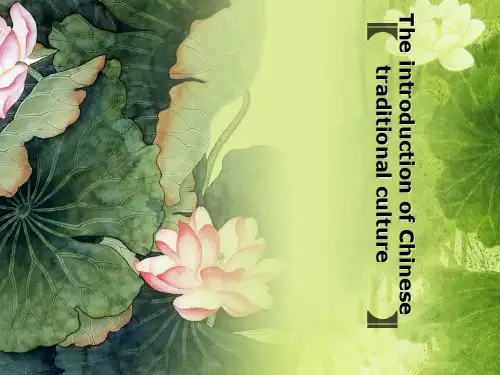
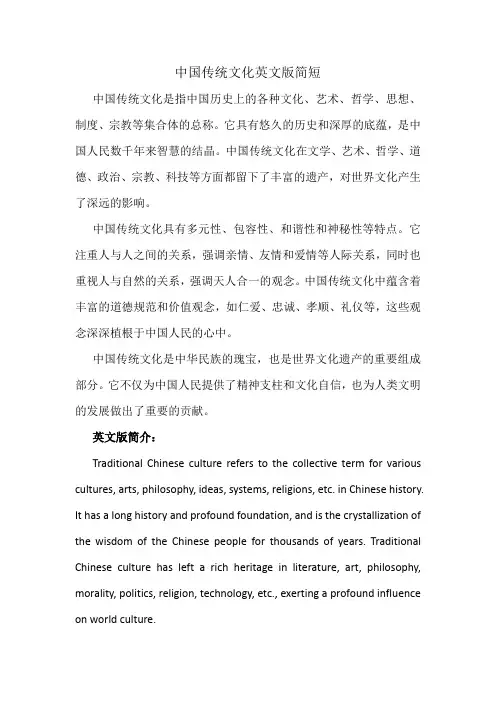
中国传统文化英文版简短中国传统文化是指中国历史上的各种文化、艺术、哲学、思想、制度、宗教等集合体的总称。
它具有悠久的历史和深厚的底蕴,是中国人民数千年来智慧的结晶。
中国传统文化在文学、艺术、哲学、道德、政治、宗教、科技等方面都留下了丰富的遗产,对世界文化产生了深远的影响。
中国传统文化具有多元性、包容性、和谐性和神秘性等特点。
它注重人与人之间的关系,强调亲情、友情和爱情等人际关系,同时也重视人与自然的关系,强调天人合一的观念。
中国传统文化中蕴含着丰富的道德规范和价值观念,如仁爱、忠诚、孝顺、礼仪等,这些观念深深植根于中国人民的心中。
中国传统文化是中华民族的瑰宝,也是世界文化遗产的重要组成部分。
它不仅为中国人民提供了精神支柱和文化自信,也为人类文明的发展做出了重要的贡献。
英文版简介:Traditional Chinese culture refers to the collective term for various cultures, arts, philosophy, ideas, systems, religions, etc. in Chinese history. It has a long history and profound foundation, and is the crystallization of the wisdom of the Chinese people for thousands of years. Traditional Chinese culture has left a rich heritage in literature, art, philosophy, morality, politics, religion, technology, etc., exerting a profound influence on world culture.Traditional Chinese culture has the characteristics of diversity, inclusivity, harmony, and mystery. It emphasizes the relationship between people, emphasizing interpersonal relationships such as family ties, friendship, and love, while also emphasizing the relationship between man and nature, emphasizing the concept of harmony between heaven and earth. Traditional Chinese culture contains a rich vocabulary of moral norms and values such as benevolence, loyalty, filial piety, and etiquette, which are deeply ingrained in the hearts of the Chinese people.Traditional Chinese culture is a national treasure of the Chinese nation and an important part of world cultural heritage. It not only provides a spiritual pillar and cultural confidence for the Chinese people, but also makes an important contribution to the development of human civilization.。
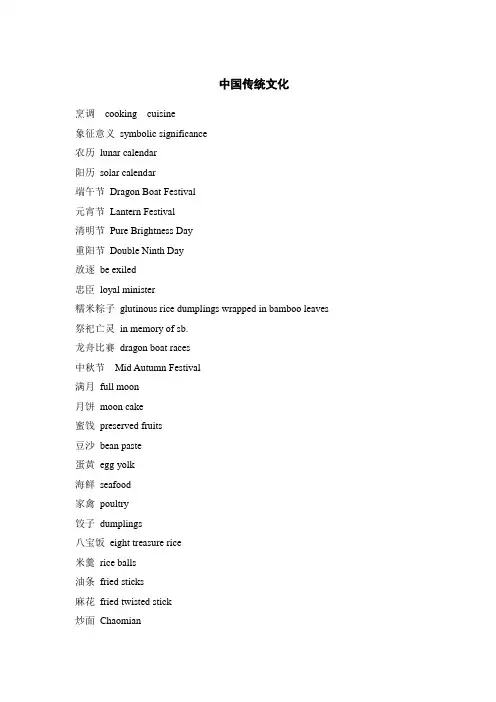
中国传统文化烹调cooking cuisine象征意义symbolic significance农历lunar calendar阳历solar calendar端午节Dragon Boat Festival元宵节Lantern Festival清明节Pure Brightness Day重阳节Double Ninth Day放逐be exiled忠臣loyal minister糯米粽子glutinous rice dumplings wrapped in bamboo leaves 祭祀亡灵in memory of sb.龙舟比赛dragon boat races中秋节Mid Autumn Festival满月full moon月饼moon cake蜜饯preserved fruits豆沙bean paste蛋黄egg yolk海鲜seafood家禽poultry饺子dumplings八宝饭eight treasure rice米羹rice balls油条fried sticks麻花fried twisted stick炒面Chaomian叉烧包steamed bun with roast pork粥porridge芋头taro葱油饼pan-fried cake with sesame seeds and green onion有关春节的常用词放鞭炮let off firecrackers耍龙灯play the dragon lantern耍狮子play the lion dance拜年pay a new-year call中国古代独特事物(Unique Ancient Chinese Items)宣纸rice paper衙门yamen叩头kowtow孔子Confucius武术 wushu(Chinese Martial Arts)功夫kungfu ;kung fu中庸the way of medium (cf. Golden Means)中和harmony (zhonghe)孝顺to show filial obedience孝子dutiful son家长family head三纲:君为臣纲,父为子纲,夫为妻纲three cardinal guides: ruler guides subject, father guides son husband guides wife五常:仁、义、理、智、信five constant virtues: benevolence (humanity), righteousness, propriety, wisdom and fidelity八股文eight-legged essays多子多福:The more sons/children, the more blessing/ great happiness养儿防老:raising sons to support one in one’s old age1.元宵节:Lantern Festival2.刺绣:embroidery3.重阳节:Double-Ninth Festival4.清明节:Tomb sweeping day5.剪纸:Paper Cutting6.书法:Calligraphy7.对联:(Spring Festival) Couplets8.象形文字:Pictograms/Pictographic Characters9.人才流动:Brain Drain/Brain Flow10.四合院:Siheyuan/Quadrangle11.战国:Warring States12.风水:Fengshui/Geomantic Omen13.铁饭碗:Iron Bowl14.函授部:The Correspondence Department15.集体舞:Group Dance16.黄土高原:Loess Plateau17.红白喜事:Weddings and Funerals18.中秋节:Mid-Autumn Day19.结婚证:Marriage Certificate20.儒家文化:Confucian Culture21.附属学校:Affiliated school22.古装片:Costume Drama23.武打片:Chinese Swordplay Movie24.元宵:Tangyuan/Sweet Rice Dumpling (Soup)25.一国两制:One Country, Two Systems26.火锅:Hot Pot27.四人帮:Gang of Four28.《诗经》:The Book of Songs29.素质教育:Essential-qualities-oriented Education30.《史记》:Historical Records/Records of the Grand Historian31.大跃进:Great Leap Forward (Movement)32.《西游记》:The Journey to the West33.除夕:Chinese New Year’s Eve/Eve of the Spring Festival34.针灸:Acupuncture35.唐三彩:Tri-color Pottery of the Tang Dynasty/ The Tang Tri-colored pottery36.中国特色的社会主义:Chinese-charactered Socialist/Socialist with Chinese characteristics37.偏旁:radical38.孟子:Mencius39.亭/阁:Pavilion/ Attic40.大中型国有企业:Large and Medium-sized State-owned Enterprises41.火药:gunpowder42.农历:Lunar Calendar43. 印/玺:Seal/Stamp44. 物质精神文明建设:The Construction of Material Civilization and Spiritual Civilization45.京剧:Beijing Opera/Peking Opera46.秦腔:Crying of Qin People/Qin Opera47.太极拳:Tai Chi实考题分析中国的传统节庆膳食除了在数量和质量上与平时有所不同之外,一些历史悠久、具有象征意义的食物也是节日必不可缺的伴侣。
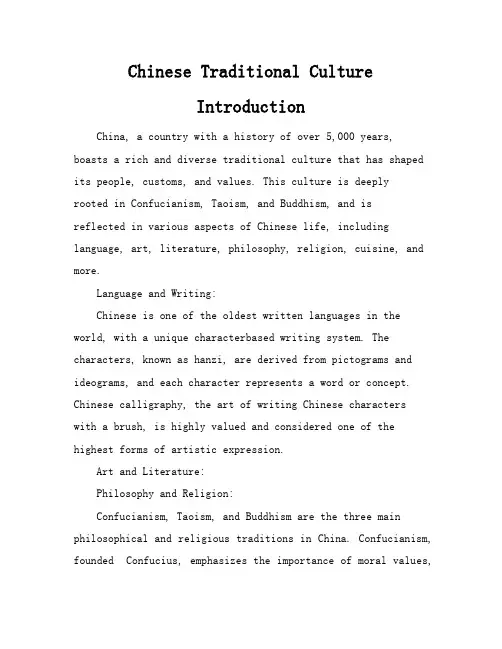
Chinese Traditional CultureIntroductionChina, a country with a history of over 5,000 years, boasts a rich and diverse traditional culture that has shaped its people, customs, and values. This culture is deeplyrooted in Confucianism, Taoism, and Buddhism, and isreflected in various aspects of Chinese life, including language, art, literature, philosophy, religion, cuisine, and more.Language and Writing:Chinese is one of the oldest written languages in the world, with a unique characterbased writing system. The characters, known as hanzi, are derived from pictograms and ideograms, and each character represents a word or concept. Chinese calligraphy, the art of writing Chinese characterswith a brush, is highly valued and considered one of the highest forms of artistic expression.Art and Literature:Philosophy and Religion:Confucianism, Taoism, and Buddhism are the three main philosophical and religious traditions in China. Confucianism, founded Confucius, emphasizes the importance of moral values,social harmony, and filial piety. Taoism, founded Laozi, emphasizes the pursuit of harmony with nature and the Tao, or the Way. Buddhism, which originated in India, focuses on the Four Noble Truths and the Eightfold Path as a means to achieve enlightenment and escape suffering.Cuisine:Chinese cuisine is one of the most diverse and flavorful in the world, with a wide variety of regional styles and dishes. Some of the most famous Chinese dishes include Peking duck, dim sum, hot pot, and dumplings. Chinese cooking techniques are also diverse, including stirfrying, steaming, boiling, and roasting.Festivals and Celebrations:China has a rich tradition of festivals and celebrations, many of which are based on the lunar calendar. Some of the most important festivals include the Spring Festival (Chinese New Year), the MidAutumn Festival, the Dragon Boat Festival, and the Lantern Festival. These festivals are celebrated with traditional customs, such as lighting lanterns, eating special foods, and watching fireworks.Traditional Medicine:Traditional Chinese medicine (TCM) is a holistic system of medicine that has been practiced for thousands of years. TCM emphasizes the balance of yin and yang, and the use ofherbal remedies, acupuncture, and other treatments to promote health and wellbeing.Conclusion:Chinese traditional culture is a treasure trove of knowledge, wisdom, and beauty. It continues to influence the lives of people in China and around the world, and is a valuable resource for understanding the history and development of human civilization.ContinuedArchitecture and Gardens:Chinese architecture is renowned for its intricate designs, use of wood, and emphasis on harmony with nature. Traditional Chinese buildings often feature curved roofs, red columns, and decorative elements such as dragons and phoenixes. Chinese gardens, known for their balance of water, rocks, plants, and architecture, are designed to create a serene and contemplative atmosphere.Music and Dance:Chinese music has a long history, with various instruments such as the guqin (a sevenstringed zither), erhu (a twostringed fiddle), and pipa (a fourstringed lute). Traditional Chinese dance is also diverse, ranging from优雅的宫廷舞到欢快的民间舞,每一种舞蹈都有其独特的风格和意义。
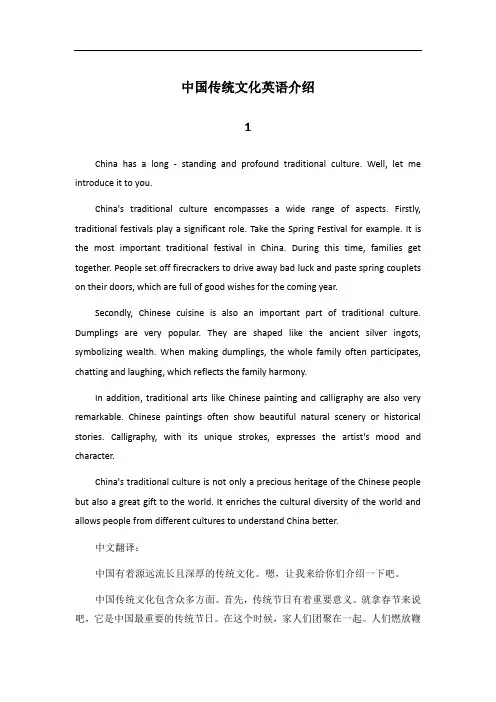
中国传统文化英语介绍1China has a long -standing and profound traditional culture. Well, let me introduce it to you.China's traditional culture encompasses a wide range of aspects. Firstly, traditional festivals play a significant role. Take the Spring Festival for example. It is the most important traditional festival in China. During this time, families get together. People set off firecrackers to drive away bad luck and paste spring couplets on their doors, which are full of good wishes for the coming year.Secondly, Chinese cuisine is also an important part of traditional culture. Dumplings are very popular. They are shaped like the ancient silver ingots, symbolizing wealth. When making dumplings, the whole family often participates, chatting and laughing, which reflects the family harmony.In addition, traditional arts like Chinese painting and calligraphy are also very remarkable. Chinese paintings often show beautiful natural scenery or historical stories. Calligraphy, with its unique strokes, expresses the artist's mood and character.China's traditional culture is not only a precious heritage of the Chinese people but also a great gift to the world. It enriches the cultural diversity of the world and allows people from different cultures to understand China better.中文翻译:中国有着源远流长且深厚的传统文化。
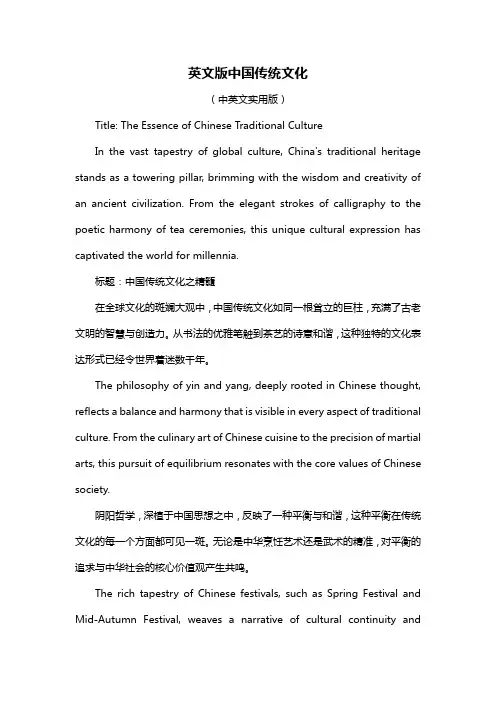
英文版中国传统文化(中英文实用版)Title: The Essence of Chinese Traditional CultureIn the vast tapestry of global culture, China's traditional heritage stands as a towering pillar, brimming with the wisdom and creativity of an ancient civilization. From the elegant strokes of calligraphy to the poetic harmony of tea ceremonies, this unique cultural expression has captivated the world for millennia.标题:中国传统文化之精髓在全球文化的斑斓大观中,中国传统文化如同一根耸立的巨柱,充满了古老文明的智慧与创造力。
从书法的优雅笔触到茶艺的诗意和谐,这种独特的文化表达形式已经令世界着迷数千年。
The philosophy of yin and yang, deeply rooted in Chinese thought, reflects a balance and harmony that is visible in every aspect of traditional culture. From the culinary art of Chinese cuisine to the precision of martial arts, this pursuit of equilibrium resonates with the core values of Chinese society.阴阳哲学,深植于中国思想之中,反映了一种平衡与和谐,这种平衡在传统文化的每一个方面都可见一斑。
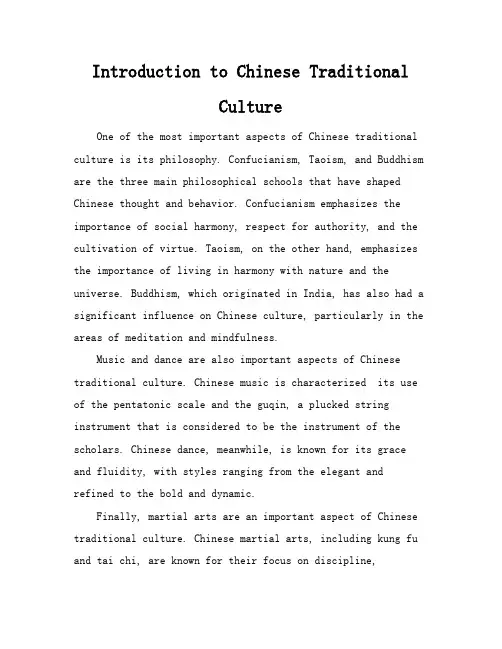
Introduction to Chinese TraditionalCultureOne of the most important aspects of Chinese traditional culture is its philosophy. Confucianism, Taoism, and Buddhism are the three main philosophical schools that have shaped Chinese thought and behavior. Confucianism emphasizes the importance of social harmony, respect for authority, and the cultivation of virtue. Taoism, on the other hand, emphasizes the importance of living in harmony with nature and the universe. Buddhism, which originated in India, has also had a significant influence on Chinese culture, particularly in the areas of meditation and mindfulness.Music and dance are also important aspects of Chinese traditional culture. Chinese music is characterized its use of the pentatonic scale and the guqin, a plucked string instrument that is considered to be the instrument of the scholars. Chinese dance, meanwhile, is known for its grace and fluidity, with styles ranging from the elegant andrefined to the bold and dynamic.Finally, martial arts are an important aspect of Chinese traditional culture. Chinese martial arts, including kung fu and tai chi, are known for their focus on discipline,selfdefense, and the cultivation of inner strength. These martial arts are also closely linked to Chinese philosophy, with many of the principles and techniques being derived from Taoist and Buddhist teachings.。